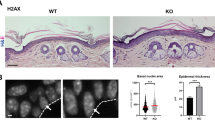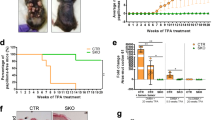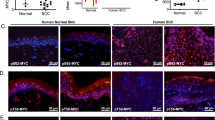Abstract
Chk1 is a key regulator of DNA damage checkpoint responses and genome stability in eukaryotes. To better understand how checkpoint proficiency relates to cancer development, we investigated the effects of genetic ablation of Chk1 in the mouse skin on tumors induced by chemical carcinogens. We found that homozygous deletion of Chk1 immediately before carcinogen exposure strongly suppressed benign tumor (papilloma) formation, and that the few, small lesions that formed in the ablated skin always retained Chk1 expression. Remarkably, Chk1 deletion rapidly triggered spontaneous cell proliferation, γ-H2AX staining and apoptosis within the hair follicle, a principal site of origin for carcinogen-induced tumors. At later times, the ablated skin was progressively repopulated by non-recombined Chk1-expressing cells and ultimately normal sensitivity to tumor induction was restored when carcinogen treatment was delayed. In marked contrast, papillomas formed normally in Chk1 hemizygous skin but showed an increased propensity to progress to carcinoma. Thus, complete loss of Chk1 is incompatible with epithelial tumorigenesis, whereas partial loss of function (haploinsufficiency) fosters benign malignant tumor progression.
This is a preview of subscription content, access via your institution
Access options
Subscribe to this journal
Receive 50 print issues and online access
$259.00 per year
only $5.18 per issue
Buy this article
- Purchase on Springer Link
- Instant access to full article PDF
Prices may be subject to local taxes which are calculated during checkout





Similar content being viewed by others
References
Abel EL, Angel JM, Kiguchi K, DiGiovanni J . (2009). Multi-stage chemical carcinogenesis in mouse skin: fundamentals and applications. Nat Protoc 4: 1350–1362.
Ashwell S, Janetka JW, Zabludoff S . (2008). Keeping checkpoint kinases in line: new selective inhibitors in clinical trials. Expert Opin Investig Drugs 17: 1331–1340.
Bartek J, Lukas J . (2003). Chk1 and Chk2 kinases in checkpoint control and cancer. Cancer Cell 3: 421–429.
Bartkova J, Rezaei N, Liontos M, Karakaidos P, Kletsas D, Issaeva N et al. (2006). Oncogene-induced senescence is part of the tumorigenesis barrier imposed by DNA damage checkpoints. Nature 444: 633–637.
Bolderson E, Richard DJ, Zhou BB, Khanna KK . (2009). Recent advances in cancer therapy targeting proteins involved in DNA double-strand break repair. Clin Cancer Res 15: 6314–6320.
Braun KM, Niemann C, Jensen UB, Sundberg JP, Silva-Vargas V, Watt FM . (2003). Manipulation of stem cell proliferation and lineage commitment: visualisation of label-retaining cells in wholemounts of mouse epidermis. Development 130: 5241–5255.
Di Micco R, Fumagalli M, Cicalese A, Piccinin S, Gasparini P, Luise C et al. (2006). Oncogene-induced senescence is a DNA damage response triggered by DNA hyper-replication. Nature 444: 638–642.
Fishler T, Li YY, Wang RH, Kim HS, Sengupta K, Vassilopoulos A et al. (2010). Genetic instability and mammary tumor formation in mice carrying mammary-specific disruption of Chk1 and p53. Oncogene 29: 4007–4017.
Greenow KR, Clarke AR, Jones RH . (2009). Chk1 deficiency in the mouse small intestine results in p53-independent crypt death and subsequent intestinal compensation. Oncogene 28: 1443–1453.
Hoeijmakers JH . (2009). DNA damage, aging, and cancer. N Engl J Med 361: 1475–1485.
Indra AK, Warot X, Brocard J, Bornert JM, Xiao JH, Chambon P et al. (1999). Temporally-controlled site-specific mutagenesis in the basal layer of the epidermis: comparison of the recombinase activity of the tamoxifen-inducible Cre-ER(T) and Cre-ER(T2) recombinases. Nucleic Acids Res 27: 4324–4327.
Jaks V, Barker N, Kasper M, van Es JH, Snippert HJ, Clevers H et al. (2008). Lgr5 marks cycling, yet long-lived, hair follicle stem cells. Nat Genet 40: 1291–1299.
Kangsamaksin T, Park HJ, Trempus CS, Morris RJ . (2007). A perspective on murine keratinocyte stem cells as targets of chemically induced skin cancer. Mol Carcinog 46: 579–584.
Kemp CJ . (2005). Multistep skin cancer in mice as a model to study the evolution of cancer cells. Semin Cancer Biol 15: 460–473.
Lam MH, Liu Q, Elledge SJ, Rosen JM . (2004). Chk1 is haploinsufficient for multiple functions critical to tumor suppression. Cancer Cell 6: 45–59.
Li L, Clevers H . (2010). Coexistence of quiescent and active adult stem cells in mammals. Science 327: 542–545.
Liu Q, Guntuku S, Cui XS, Matsuoka S, Cortez D, Tamai K et al. (2000). Chk1 is an essential kinase that is regulated by Atr and required for the G(2)/M DNA damage checkpoint. Genes Dev 14: 1448–1459.
McLean GW, Komiyama NH, Serrels B, Asano H, Reynolds L, Conti F et al. (2004). Specific deletion of focal adhesion kinase suppresses tumor formation and blocks malignant progression. Genes Dev 18: 2998–3003.
Mulherkar R, Kirtane BM, Ramchandani A, Mansukhani NP, Kannan S, Naresh KN . (2003). Expression of enhancing factor/phospholipase A2 in skin results in abnormal epidermis and increased sensitivity to chemical carcinogenesis. Oncogene 22: 1936–1944.
Niida H, Murata K, Shimada M, Ogawa K, Ohta K, Suzuki K et al. (2010). Cooperative functions of Chk1 and Chk2 reduce tumour susceptibility in vivo. EMBO J 29: 3558–3570.
Snippert HJ, Haegebarth A, Kasper M, Jaks V, van Es JH, Barker N et al. (2010). Lgr6 marks stem cells in the hair follicle that generate all cell lineages of the skin. Science 327: 1385–1389.
Syljuasen RG, Sorensen CS, Hansen LT, Fugger K, Lundin C, Johansson F et al. (2005). Inhibition of human Chk1 causes increased initiation of DNA replication, phosphorylation of ATR targets, and DNA breakage. Mol Cell Biol 25: 3553–3562.
Takai H, Tominaga K, Motoyama N, Minamishima YA, Nagahama H, Tsukiyama T et al. (2000). Aberrant cell cycle checkpoint function and early embryonic death in Chk1(-/-) mice. Genes Dev 14: 1439–1447.
Toledo LI, Murga M, Gutierrez-Martinez P, Soria R, Fernandez-Capetillo O . (2008). ATR signaling can drive cells into senescence in the absence of DNA breaks. Genes Dev 22: 297–302.
Vogelstein B, Kinzler KW . (2004). Cancer genes and the pathways they control. Nat Med 10: 789–799.
Zaugg K, Su YW, Reilly PT, Moolani Y, Cheung CC, Hakem R et al. (2007). Cross-talk between Chk1 and Chk2 in double-mutant thymocytes. Proc Natl Acad Sci USA 104: 3805–3810.
Acknowledgements
We thank Cancer Research UK (CR-UK), Marie Curie EU and the Royal College of Radiologists for financial support, Drs S Elledge, J Rosen and M Lam for the kind gift of reagents, as well as Dr G Inman for constructive comments on the manuscript. LMT was the recipient of a joint CRUK: Royal College of Radiologists fellowship and SL was the recipient of a Marie Curie fellowship.
Author information
Authors and Affiliations
Corresponding author
Ethics declarations
Competing interests
The authors declare no conflict of interest.
Additional information
Supplementary Information accompanies the paper on the Oncogene website
Rights and permissions
About this article
Cite this article
Tho, L., Libertini, S., Rampling, R. et al. Chk1 is essential for chemical carcinogen-induced mouse skin tumorigenesis. Oncogene 31, 1366–1375 (2012). https://doi.org/10.1038/onc.2011.326
Received:
Revised:
Accepted:
Published:
Issue Date:
DOI: https://doi.org/10.1038/onc.2011.326
Keywords
This article is cited by
-
HJURP is recruited to double-strand break sites and facilitates DNA repair by promoting chromatin reorganization
Oncogene (2024)
-
Chk1 Inhibition Ameliorates Alzheimer's Disease Pathogenesis and Cognitive Dysfunction Through CIP2A/PP2A Signaling
Neurotherapeutics (2022)
-
Downregulation of c-Myc expression confers sensitivity to CHK1 inhibitors in hematologic malignancies
Acta Pharmacologica Sinica (2022)
-
Targeting ATR in cancer
Nature Reviews Cancer (2018)
-
Checkpoint Kinase 1 Expression Predicts Poor Prognosis in Nigerian Breast Cancer Patients
Molecular Diagnosis & Therapy (2018)



